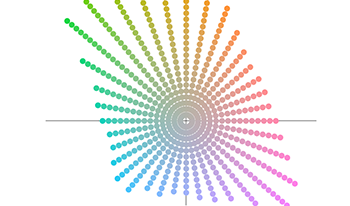

. A new color space, IGPGTG, was developed. IGPGTG uses the same structure as IPT, an established hue-uniform color space utilized in gamut mapping applications. While IPT was fit to visual data on the perceived hue, IGPGTG was optimized based on evidence linking the peak wavelength of Gaussian-shaped light spectra to their perceived hues. The performance of IGPGTG on perceived hue data was compared to the performance of other established color spaces. Additionally, an experiment was run to directly compare the hue linearity of IGPGTG with those of other color spaces by using Case V of Thurstone's law of comparative judgment to generate hue-linearity scales. IGPGTG performed well in this experiment but poorly on extant visual data. The mixed results indicate that it is possible to derive a moderately hue-linear color space without visual data.

Due to concern that current U.S. Air Force depth perception standards and test procedures may not be adequate for accurately identifying aircrew medically fit to perform critical depth perception tasks during flight, the U.S. Air Force School of Aerospace Medicine developed a stereoscopic simulation environment to investigate depth perception vision standards. The initial results of this research showed that while the use of stereoscopic displays clearly improved performance for a helicopter landing task involving depth judgments, an individual's stereo acuity was not predictive of performance. However, landing task performance could be predicted when stereo acuity was used together with binocular fusion range. However, motion perception was a better predictor of performance than stereo acuity. Potential implications for medical vision standards and the potential complexities involved in predicting real-world performance based on performance in a stereoscopic flight simulation are discussed.

Research on the role of human stereopsis has largely focused on laboratory studies that control or eliminate other cues to depth. However, in everyday environments we rarely rely on a single source of depth information. Despite this, few studies have assessed the impact of binocular vision on depth judgements in real-world scenarios presented in simulation. Here we conducted a series of experiments to determine if, and to what extent, stereoscopic depth provides a benefit for tasks commonly performed by helicopter aircrew. We assessed the impact of binocular vision and stereopsis on perception of (1) relative and (2) absolute distance above the ground (altitude) using natural and simulated stereoscopic-3D (S3D) imagery. The results showed that, consistent with the literature, binocular vision provides very weak input to absolute altitude estimates at high altitudes (10-100ft). In contrast, estimates of relative altitude at low altitudes (0-5ft) were critically dependent on stereopsis, irrespective of terrain type. These findings are consistent with the view that stereopsis provides important information for altitude judgments when close to the ground; while at high altitudes these judgments are based primarily on the perception of 2D cues.